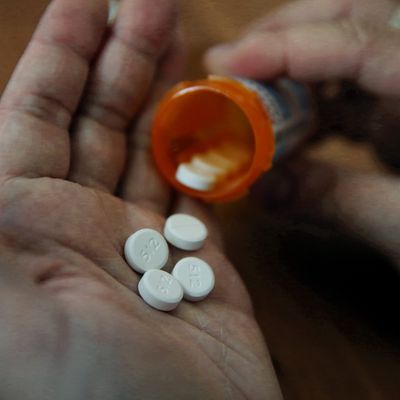
Fans of the TV show Girls will remember the moment this past season when one of the lead characters, Marnie, discovers that her eccentric husband has been addicted to OxyContin throughout the entirety of their marriage. Granted, it wasn’t exactly the longest of marriages, but still, it felt like a little bit of a preposterous plot twist. After all, how could anyone miss all the signs?
Well. It turns out that it’s a lot easier than you might think. In a new national survey, researchers from Michigan State University examined mental-health literacy across four major issues — including anxiety, depression, alcohol and prescription-drug abuse — and found that out of 4,600 respondents, a full 32 percent were unable to identify the signs of pill addiction. Men and urban dwellers were particularly bad at knowing when something was amiss.
I don’t need to tell you that these are alarming findings. We’re currently living through the worst drug crisis in American history; in 2016 alone, more than 59,000 people died from drug overdoses, many of them from prescription opioids. “My sense is that people just don’t recognize the risk factor or take the necessary precautions to look at what’s happening,” says Michigan State economics professor Mark Skidmore, director of behavioral-health organization CAPE and a co-investigator on the survey. “Loved ones around may not be watching whether or not a prescription is being followed.”
This may prove difficult, though, when you consider that opioid abuse — whose signs include mood swings, changes in energy level, and confusion or poor judgment, among other things — can be relatively easy to hide from family and friends. In a recent article for Vice, writer Emily Cassel recounted the story of a man who hid his addiction from loved ones for close to 20 years; plenty of others have shared similar experiences of struggling through a secret addiction while keeping their family and friends in the dark.
While it might seem like anyone with common sense could pick up on these abnormal behavioral cues, according to Daniel Bradford, a researcher in the Addiction Research Center at the University of Wisconsin-Madison, it may “be easier for most people to tell when someone is drunk than when someone is high on an opioid.” In part, this is because there’s not necessarily an obvious telltale sign — opioids don’t leave a scent on clothes or breath the way alcohol would, and while heroin users may have track marks on their arms, someone whose addiction takes the form of pills wouldn’t have any such markings.
For people whose addictions started with prescription drugs, there’s also the cover of seeming legitimacy. “Family and friends may indeed notice that their loved one is frequently popping pills,” Bradford explains, “but it may not appear like anything is wrong since the drug was legally prescribed by a medical professional.” And it’s that line between normal and problematic use that can easily become blurry.
For this reason, psychiatrist Jed Magen, a Michigan State professor who specializes in the psychological effects of opioid use, recommends that family members pay more attention to what’s being prescribed during medical visits. Brushing up on the signs of drug abuse, he says, may also help stop a problem before it develops into an addiction. “Being aware of what is being prescribed and knowing something about what’s happening in your community are reasonable responses,” he says.
Likewise, Skidmore encourages people to stay connected to their loved ones when they’re taking a prescription drug. “Is it a bad thing to take medication when you’re in extreme pain? I don’t think so,” he says, “but we know that opioid-based pain medications are very addictive. And we have to be careful.”
Even if someone does notice something amiss, though, it can be hard to know what to do next. In one of the survey’s more surprising discoveries, nearly 80 percent of respondents didn’t recognize prescription-drug abuse as a treatable problem. Maybe even more alarmingly, many said that if they did notice a loved one’s addiction, they were much more likely to recommend self-help strategies than professional help.
This misunderstanding of addiction, Bradford explains, only reinforces the stigma surrounding it, which in turn can further discourage people from getting the treatment they need. On the flip side, he adds, education that helps people learn about prescription drugs’ side effects and addictive potential, as well as the current scientific understanding of addiction, can help reduce harmful stigma and protect against abuse.
And one could argue that this same pattern also applies to the other mental-health issues covered in the survey. As Skidmore notes, there’s often overlap between them: People struggling with depression or anxiety, for example, may turn to prescription drugs to help them with the issues they’re having. The survey authors also found that when respondents were given a description of a hypothetical person struggling with some form of mental illness, they judged less harshly when they were given the name (like “depression” or “addiction”) than when they were just provided with a collection of symptoms.
The survey’s takeaway, then, is that combating the stigma of addiction may require a two-pronged approach, one that requires open discussion about mental-health issues on a policy level, while also forcing us to address our individual prejudices. Recognizing and stopping addiction when it happens is about being more aware and staying connected to one another — and this applies as much to our homes as it does to the communities we live in.




